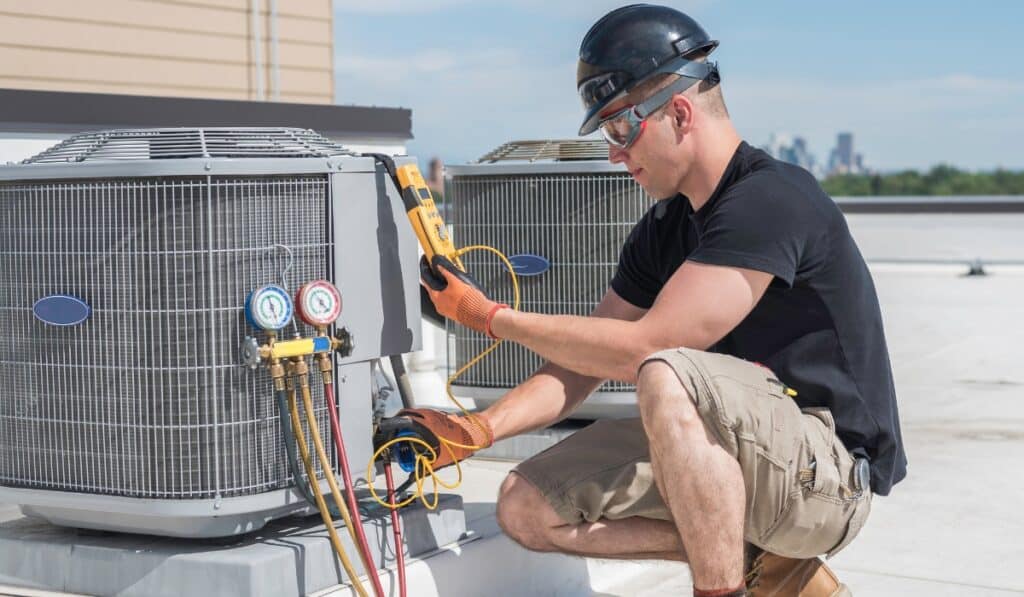SEER, or Seasonal Energy Efficiency Ratio, is a measure of an air conditioning unit’s efficiency over the course of a typical cooling season. It’s a crucial rating system that helps consumers evaluate the energy efficiency of different HVAC systems, ultimately allowing them to make informed purchasing decisions and potentially save money on their utility bills.
The Higher the SEER Rating, the Better
A higher SEER rating indicates that the air conditioning unit is more energy-efficient, meaning it uses less electricity to produce the same amount of cooling. In simple terms, a unit with a higher SEER rating will cost less to operate than a unit with a lower SEER rating, resulting in lower energy bills for homeowners and businesses.
Decoding the SEER Rating Scale
SEER ratings are calculated by dividing the total cooling output (in British Thermal Units or BTUs) by the total electrical energy input (in watt-hours) over an entire cooling season. The resulting number is the SEER rating.
- SEER ratings range from a minimum of 13 for newer models to over 25 for the most energy-efficient units on the market.
- The higher the SEER rating, the more energy-efficient the air conditioning system.
- For example, a unit with a SEER rating of 16 is approximately 13% more efficient than a unit with a SEER rating of 13.
Understanding the SEER Rating Requirements
In the United States, the Department of Energy (DOE) sets minimum SEER requirements for air conditioning units. These requirements vary based on the type of system and the region in which it is installed.
- As of January 1, 2023, the minimum SEER rating for central air conditioners in the northern United States is 13, while in the southern United States, it is 14.
- For split-system air conditioners, the minimum SEER rating is 14 nationwide.
- These minimum requirements are subject to change as energy efficiency standards continue to evolve.
Factors Affecting SEER Ratings

Several factors can influence the SEER rating of an air conditioning unit, including:
1. Unit Size and Capacity
Generally, larger air conditioning units tend to have higher SEER ratings than smaller units. This is because larger units can operate more efficiently at their optimal capacity, while smaller units may need to cycle on and off more frequently, reducing their overall efficiency.
2. Refrigerant Type
The type of refrigerant used in an air conditioning system can also impact its SEER rating. Newer refrigerants, such as R-410A, tend to be more energy-efficient than older refrigerants like R-22, which is being phased out due to its environmental impact.
3. Compressor Efficiency
The compressor is the heart of an air conditioning system, and its efficiency plays a significant role in determining the overall SEER rating. More efficient compressors, such as variable-speed or inverter-driven compressors, can help improve the SEER rating of a unit.
4. Ductwork and Installation
Proper ductwork design and installation can also affect the SEER rating of an air conditioning system. Poorly sealed or undersized ductwork can lead to air leaks and inefficiencies, reducing the overall energy efficiency of the system.
Benefits of High SEER Ratings
Investing in an air conditioning system with a high SEER rating can provide several benefits, including:
1. Lower Energy Costs
The primary benefit of a high SEER rating is lower energy costs. By using less electricity to produce the same amount of cooling, homeowners and businesses can save money on their monthly utility bills.
2. Reduced Environmental Impact
Higher SEER ratings translate to lower energy consumption, which means a smaller carbon footprint and a reduced environmental impact. This can be particularly important for individuals and organizations committed to sustainability.
3. Increased Home Value
Installing a high-efficiency air conditioning system can potentially increase the value of your home. Energy-efficient homes are more attractive to potential buyers, who may be willing to pay a premium for the long-term savings on utility bills.
4. Improved Comfort
In addition to energy savings, high SEER ratings can also contribute to improved indoor comfort. More efficient systems often provide better temperature control and humidity management, resulting in a more comfortable living or working environment.
Choosing the Right SEER Rating for Your Needs
When selecting a new air conditioning system, it’s essential to consider your specific needs and requirements to ensure you choose the right SEER rating.
Factors to Consider
- Climate: In hotter climates, a higher SEER rating may be more beneficial to offset the increased cooling demands.
- Usage patterns: If you plan to use your air conditioning system frequently, a higher SEER rating can provide greater energy savings over time.
- Initial cost vs. long-term savings: While higher SEER units often have a higher upfront cost, they can provide substantial long-term savings on energy bills.
- Local rebates and incentives: Some utility companies and government programs offer rebates or incentives for installing high-efficiency HVAC systems, which can offset the initial cost.
Finding the Sweet Spot
Striking the right balance between upfront cost and long-term energy savings is crucial when choosing a SEER rating. While the highest SEER rating available may seem tempting, it may not always be the most cost-effective option for your specific situation.
It’s essential to work with a reputable HVAC professional who can assess your home’s cooling needs, local climate, and usage patterns to recommend the most appropriate SEER rating for your circumstances.
Maintaining Your HVAC System for Optimal Efficiency
Even after installing a high-efficiency air conditioning system with a good SEER rating, proper maintenance is essential to ensure it continues to operate at peak performance.
Regular Maintenance Checklist
- Change air filters regularly (every 1-3 months)
- Clean the outdoor condenser unit
- Check for refrigerant leaks
- Inspect and clean the ductwork
- Have a professional HVAC technician perform an annual tune-up
By adhering to a regular maintenance schedule, you can help extend the lifespan of your air conditioning system, maintain its energy efficiency, and avoid costly repairs or premature replacements.
Understanding SEER vs. EER Ratings
While SEER ratings are a crucial factor in evaluating the energy efficiency of air conditioning systems, it’s also important to understand the difference between SEER and EER (Energy Efficiency Ratio) ratings.
What is EER?
EER is a measure of an air conditioning unit’s efficiency at a specific outdoor temperature, typically 95°F (35°C). It represents the ratio of the unit’s cooling output (in BTUs) to its energy input (in watt-hours) at that specific temperature.
SEER vs. EER: What’s the Difference?
- SEER ratings provide an overall efficiency measure for an entire cooling season, taking into account varying outdoor temperatures and humidity levels.
- EER ratings, on the other hand, provide a snapshot of efficiency at a specific outdoor temperature, which may not accurately reflect real-world conditions.
Here’s more content continuing the blog post:
Regional Considerations for SEER Ratings

The climate and geographical location can significantly impact the optimal SEER rating for your air conditioning system. Different regions may have varying energy efficiency standards and requirements.
Hot and Humid Climates
In hot and humid climates, such as the southern United States and coastal regions, higher SEER ratings are generally recommended. These areas experience prolonged periods of high temperatures and humidity, which can put a strain on air conditioning systems.
- A unit with a higher SEER rating can handle the increased cooling demands more efficiently, resulting in lower energy costs over time.
- In these regions, a SEER rating of 16 or higher is often recommended for maximum efficiency and cost savings.
Mild Climates
In milder climates with relatively short cooling seasons, such as the northern United States and parts of the West Coast, a slightly lower SEER rating may be more cost-effective.
- While higher SEER ratings are still beneficial, the potential energy savings may not be as significant due to the shorter cooling season.
- In these areas, a SEER rating between 14 and 16 can provide a good balance between efficiency and upfront cost.
Extreme Cold Climates
In extremely cold climates, where heating is the primary concern, the focus may shift towards the efficiency of the heating system rather than the air conditioning unit.
- In these regions, the SEER rating may not be as crucial, and homeowners should consider the efficiency ratings for the heating system, such as the HSPF (Heating Seasonal Performance Factor) for heat pumps.
It’s essential to consult with a reputable HVAC professional who understands the specific climate requirements of your region to determine the most appropriate SEER rating for your needs.
Maximizing Energy Savings with Smart Home Technology
In today’s tech-savvy world, smart home technology can play a significant role in maximizing the energy savings of your high-efficiency air conditioning system.
Programmable Thermostats
Programmable thermostats allow you to set specific temperature schedules for different times of the day and days of the week. By adjusting the temperature when you’re away from home or sleeping, you can reduce energy consumption without sacrificing comfort.
- Many programmable thermostats now offer Wi-Fi connectivity, allowing you to control your HVAC system remotely from your smartphone or other devices.
- Some advanced models can even learn your temperature preferences and adjust the settings accordingly, further optimizing energy efficiency.
Smart Home Integration
Integration with smart home systems can take energy savings to the next level by automatically adjusting your HVAC settings based on various factors, such as:
- Occupancy sensors that detect when rooms are empty and adjust the temperature accordingly
- Weather data integration to optimize settings based on outdoor conditions
- Integration with smart lighting and window coverings to manage heat gain and loss
By leveraging smart home technology, you can ensure that your high-efficiency air conditioning system is operating at peak performance, maximizing energy savings and comfort.
If you’re a homeowner or business owner in the Los Angeles area looking to upgrade your air conditioning system or optimize its efficiency, TOP AC Inc. is here to help. Our team of experienced HVAC professionals can assist you in understanding SEER ratings, selecting the right system for your needs, and ensuring proper installation and maintenance for maximum energy savings.
Contact us today to schedule a consultation and take the first step towards a more energy-efficient and comfortable living or working environment.

